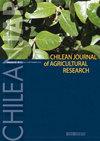Nitrogen application improved peanut yield and nitrogen use efficiency by optimizing root morphology and distribution under drought stress
IF 1.7
4区 农林科学
Q2 Agricultural and Biological Sciences
引用次数: 4
Abstract
Drought stress and nutrient deficiency are two main factors that restrict the growth and yield of peanut ( Arachis hypogaea L.) in arid and semi-arid regions. However, the effects of N fertilizer on root growth and pod yield of peanut under different water conditions are unclear. The growth, root morphology, and pod yield of peanut were studied under different water and N combinations. Two soil water treatments were tested: Well-watered (WW, 80%-85% field capacity) and drought stress conditions (DS, 55%-60% field capacity). Three N treatments were tested: no N application (NN), moderate N (MN, 90 kg ha -1 ), and high N (HN, 180 kg ha -1 ). Results showed that pod yield of peanut was limited by drought and N deficiency. Compared with NN, peanut shoot DM and pod yield were improved by MN under DS, with an average increase range of pod yield of 16.2% in the 2 yr. The annual average root length density (RLD) in the deeper soil layer (40-100 cm) was 5.5% higher under DS-MN than DS-NN treatment. The N use efficiency (NUE) was 12.3% higher under WW than DS treatment, and the NUE of MN was significantly higher than that of HN under different water treatments. Root lengths in 40-60 and 60-80 cm soil layers were also positively correlated with pod yield (r = 0.66** and 0.47**, respectively) and NUE (r = 0.60* and 0.85**, respectively). In this study, root growth in deeper soil was improved by MN application under DS, thus increasing yield and NUE of DS conditions.施氮通过优化干旱胁迫下花生根系形态和分布,提高了花生产量和氮素利用效率
干旱胁迫和营养缺乏是制约干旱半干旱区花生生长和产量的两个主要因素。然而,不同水分条件下氮肥对花生根系生长和荚果产量的影响尚不清楚。研究了不同水氮组合对花生生长、根系形态和荚果产量的影响。试验了两种土壤水分处理:水分充足(WW,田间容量80% ~ 85%)和干旱胁迫(DS,田间容量55% ~ 60%)。试验3种氮素处理:不施氮(NN)、中施氮(MN, 90 kg ha -1)和高施氮(HN, 180 kg ha -1)。结果表明,干旱和缺氮限制了花生的豆荚产量。与氮化氮处理相比,氮化氮处理提高了花生茎部DM和荚果产量,2年平均荚果产量提高16.2%,较深层(40-100 cm)年平均根长密度(RLD)比氮化氮处理高5.5%。WW处理的氮素利用效率(NUE)比DS处理高12.3%,不同水处理下MN的NUE均显著高于HN。40 ~ 60 cm和60 ~ 80 cm土层根长与荚果产量(r分别为0.66**和0.47**)和氮肥利用率(r分别为0.60*和0.85**)呈正相关。在本研究中,免耕条件下施用MN可促进深层土壤根系生长,从而提高免耕条件下的产量和氮肥利用效率。
本文章由计算机程序翻译,如有差异,请以英文原文为准。
求助全文
约1分钟内获得全文
求助全文
来源期刊
CiteScore
3.00
自引率
11.80%
发文量
60
审稿时长
6 months
期刊介绍:
ChileanJAR publishes original Research Articles, Scientific Notes and Reviews of agriculture, multidisciplinary and agronomy: plant production, plant protection, genetic resources and biotechnology, water management, soil sciences, environment, agricultural economics, and animal production (focused in ruminant feeding). The editorial process is a double-blind peer reviewing, Editorial Office checks format, composition, and completeness, which is a requirement to continue the editorial process. Editorial Committee and Reviewers evaluate relevance and scientific merit of manuscript.

 求助内容:
求助内容: 应助结果提醒方式:
应助结果提醒方式:


